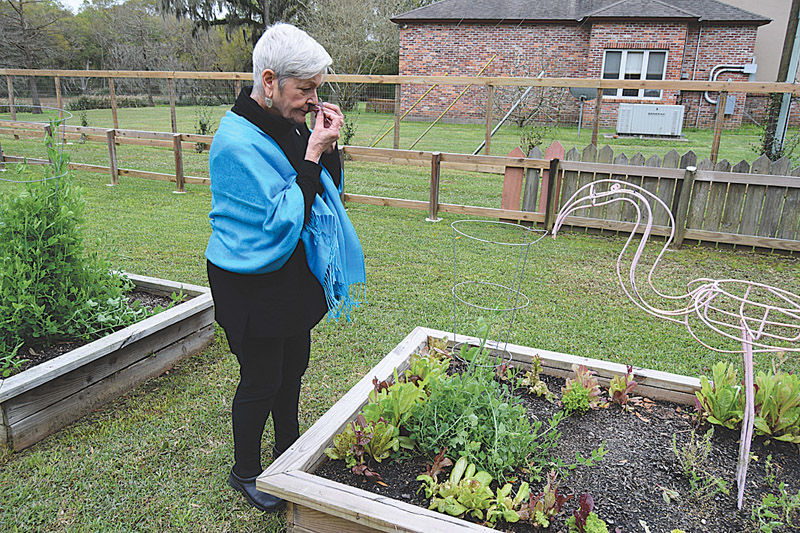Secrets and stories from A CULINARY PRO
Published 7:00 am Wednesday, March 6, 2019

- Chef Marcelle Bienvenu stops to smell the herbs still growing in one of the above ground planters in the garden next to the Bayou Teche home in St. Martinville where she lives with husband Rocky.
SHARING THE HISTORY OF FOOD IS PART OF HER KITCHEN EXPERTISE
Trending
Celebrated author and chef Marcelle Bienvenu will be sharing the inspiration behind her work, and the secrets of some of the professional classes she’s taught, from 6 to 6:45 p.m. Friday, March 8 at the St. Peter Branch Library, 1111 West St. Peter St. in New Iberia. Bienvenu has done it all when it comes to the food industry and since 2009 has been a chef/instructor at the Chef John Folse Culinary Institute at . Looking toward retiring, Bienvenu anticipates remaining active. Why not? The history, culture, cuisine and cooking Cajun is more than a brief chat with a chef — it is a great way to learn some pointers, and hear some good stories. For those unfamiliar with Chef Bienvenu, Commanders Palace in New Orleans might be a familiar name. She worked there close to restaurateur Ella Brennan as well as several restaurants before operating her own. She has written a weekly food column for more than 30 years, also contributing to many publications including the Food page in The Daily Iberian. Bienvenu is perhaps most famous for are her cookbooks “Who’s Your Mama, Are You Catholic, and Can You Make a Roux?” She has coauthored several cookbooks with celebrity chef Emeril Lagasse and even one with Cane River Pecans’ chief nut officer Jady Regard on how to cook with pecans. Registration is requested to insure your reservation. The author will be signing her books, so attendees may bring their own copies, or buy them after the program.
How did this talk originate?
I really don’t know, my publisher, Acadian House Publishing, called and asked me to talk to the library group. I was working on several projects at school. Every spring we do a research project, I have to do 20 percent, they have to do 80 percent. I had done one on the seven nations that have evolved into our culture, the Cajun/Creole Cuisine, and we did one on roux. They are a lot of fun. For years I thought it was how your mama taught you to cook a roux. There are so many other ways. Then we did a survey in the culinary program, 200 plus students. How do you make a roux? What color do you like it? The information was really fun. It seems the further west you go from Lafayette the darker the roux. I think that is from the German background on the prairies. The kids made their roux. So I’m going to do, “Who stirred the pot?” That’s about all the influences — the Germans, Italians, African-American, French, English, Indians, I’ve just added the Laotian and Asians. Their flavors are very similar to ours in that they are very bold. I told somebody, I didn’t know there was “Cajun” cuisine until Paul Prudomme said so. It’s what your mama fixed you.
Cooking, running a restaurant and teaching new chefs is a wide range of applications. What’s new?
This year I’ve been doing an online class, Culinary History of the American South. In that class I get culinary students but it also serves as a history and humanities course so I get football players, nurses, dentists, I rarely see these other kids. I try to get them to look at their family backgrounds — German, Italian, Cajun, African-American, Indian. It’s interesting to see their food-ways within those family units. It wasn’t a brown jambalaya, it had tomatoes in it — some were (turning their noses up) we’re not eating that. It became an interesting discussion on the different types of jambalaya. I also make them interview an old person to find out what was happening in the 1930s, 40s, 50s and how it has changed now. People all used to have a garden, now they eat out of a box. One of the students lives with his grandmother. He’s been cooking with her since he was a child. They’re finding out this “farm to table” movement isn’t really new — they’ve been doing it more than 40 years. Here we really maintain a lot of traditions and culture.
When Nicholls expanded the culinary facilities, some of your former students came back to see how the program has grown. Is it fun watching your proteges succeed?
Trending
I had one student who won the James Beard Award. He’s fusing Cajun and Asian, he‘s just opened the second place in New Orleans. He’s found some profound flavors that really do match. He’s just opened a second place, a smaller place, and was named Best Restaurateur in the city. One of our students is his pastry chef. She’s coming up with some new things with old traditions. It’s curious to see what they’re doing.
What are the biggest challenges to teaching as far as you’re concerned?
For the most part, young people today are not critical thinkers. I’m trying to teach them to think ahead. Things like “What do you need to take this dish to the table? One of the classes I teach is fruit, vegetables and grains. I tell all my students, they need to keep all their recipes from all the courses and when you get to bistro you’ll come back to them. We have a Bistro kitchen and restaurant for the seniors. They rotate through the different stations and can experiment on their recipes to develop their own dishes.
Someone you’ve never met is coming for dinner. What’s on the menu?
I’d be kind of conservative. I keep a little something in the freezer, like a cup of soup — turtle or cream of leek soup. Twenty years ago Hallman Woods who owned LeRosier on Main had great soups from A to Z, this was one of his recipes. Leek and Tasso is a great combination. Then I’d probably do something, my latest thing is to do en papillote, in a paper bag, ‘cause you can do whatever, chicken or fish and what ever vegetables are in season. It makes a nice show, opening up the bags with the steam rising. Years ago it was the coolest thing in New Orleans. Sometimes you’ve got to do some ol’ time things. You add herbs and you don’t need a sauce. Don’t ask me about desserts. They don’t even let me in the pastry kitchen. I make a pecan pie and a few basics, easy stuff, but no baking.

